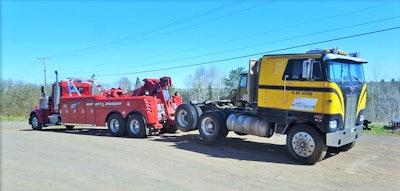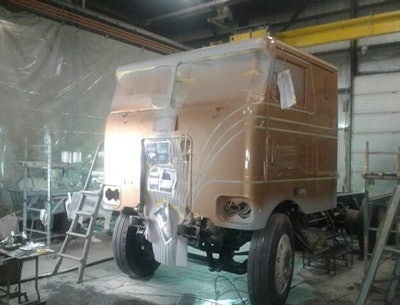
The picture above is the 1974 Peterbilt 352 of Halvor Lines of Superior, Wis., a special restoration project cabover that was finished in time for Christmas last year and the final month of Halvor’s 50th-anniversary year, notes company CEO Jon Vinje. Vinje’s father established the company in 1968 with four other owner-operators and a principle customer in Halvorson Equipment Company.
“Halvorson was a distributor for the Bombardier company,” he says, thus “distributors of the Ski-doo snowmobile. There was a snowmobile boom at the time.” The company hauled from Quebec, where Bombardier is headquartered, into the U.S. Halvor company black-and-yellow colors come from the “yellow-and-black colors of the early Ski-doo snowmobiles,” Vinje says. “It was a new new thing at the time, and they were quite popular – a lot of people had them,” particularly throughout the ‘snowbelt’ states in the Upper Midwest and in Canada.
The ’74 Pete was located as Vinje and his brother, Joe, batted around ideas for special projects on the occasion of the anniversary. Jon thought it “would be neat to restore on of the four original trucks.” Joe, having spent much of his life involved directly in the maintenance of Halvor’s trucks, agreed.

The Vinjes and company put out the call in Halvor’s social media platforms, and a Halvor driver responded with a tip. While it wasn’t an original Halvor power unit, one of the trucks he’d driven in decades gone by for the company was in fact sitting in a field at a Duluth-area construction company 20 miles due north of Superior. The rig, a Peterbilt 352 with its original small-cam Cummins engine, emblematic of Halvor’s trucks in its first decade, was eventually purchased from the owner and the restoration project got under way.
 The truck had retained the yellow-and-black Halvor paint scheme over the years when the Vinjes had it hauled back home to the shop.
The truck had retained the yellow-and-black Halvor paint scheme over the years when the Vinjes had it hauled back home to the shop. Former owner-operator of the 352 with Halvor in years gone by, Jeff Levine, is pictured on the right here with Jon (center) and Joe Vinje.
Former owner-operator of the 352 with Halvor in years gone by, Jeff Levine, is pictured on the right here with Jon (center) and Joe Vinje.Halvor has grown quite a lot since those early days — near the end of its first decade when Vinje’s father took full ownership in 1977, “the fleet had approximately 35 power units” hauling for the company, including this Peterbilt. “Today,” Jon adds, “we have 510 power units, approximately 1,400 trailers,” and haul freight on flatbeds and in dry vans and reefers.

Not long after the 1974 was in the Halvor shop getting put through its paces by Joe, who began “hands-on to work on it,” Jon says. “We were pleased he was able to turn the crankshaft over and the engine was free. With some clean diesel in a five-gallon can he soon had it running.”
While the Vinjes thought they’d really scored with it then, “after we ran it a little more we realized it had some issues,” Jon says. Blowing oil out of the exhaust, for one. “We did overhaul the original engine,” which Joe tackled himself.
Restoration proceeded piece by piece through the mechanical parts, brake lines and brakes and “a lot of electrical things,” Jon says.
The interior, then, in rougher shape than hoped for, was reupholstered to like-new spec. “It looks original,” Jon says.
 The company enlisted the help of body and paint man Jimmy Waldhalm of Town & Country Sign & Lighting, who began his maintenance career detailing trucks for Halvor Lines at age 16 and now operates the independent body shop. The frame was sandblasted and repainted. “The cab was in pretty good shape,” Vinje says, but “spent plenty time in the body shop getting prepared to paint. We used all the original parts that we could,” but put brand-new fuel tanks, new tires, and new wheels and some of the chrome products on it.
The company enlisted the help of body and paint man Jimmy Waldhalm of Town & Country Sign & Lighting, who began his maintenance career detailing trucks for Halvor Lines at age 16 and now operates the independent body shop. The frame was sandblasted and repainted. “The cab was in pretty good shape,” Vinje says, but “spent plenty time in the body shop getting prepared to paint. We used all the original parts that we could,” but put brand-new fuel tanks, new tires, and new wheels and some of the chrome products on it.Waldhalm, in keeping with the time of the rig’s production, didn’t decal any of the paint design. “He did a lot of work on the early Halvor Lines trucks,” Vinje says. “All the stripes are painted, likewise the Halvor Lines” insignia on the door, which Waldhalm painted by hand.
The truck was finished just in time for the Christmas City of the North parade in Duluth, Minn., last year.
 The second event was this display on December 21, 2018, at Halvor’s 50th-anniversary party, held at Clyde Ironworks in Duluth, pictured here in a display with two contemporary Halvor Lines trucks.
The second event was this display on December 21, 2018, at Halvor’s 50th-anniversary party, held at Clyde Ironworks in Duluth, pictured here in a display with two contemporary Halvor Lines trucks.Vinje says you can catch the Pete at numerous shows through the summer this year. “The great thing about this old truck is that even people who aren’t knowledgeable about our industry see it and they’re immediately interested. It appeals to all people,” as a piece of real history.
Next up for the fleet: Restoration as a time capsule of a 2005 Kenworth T600 that happenes to be the 250,000th truck built at Kenworth’s Chillicothe, Ohio, plant. Stay tuned.











